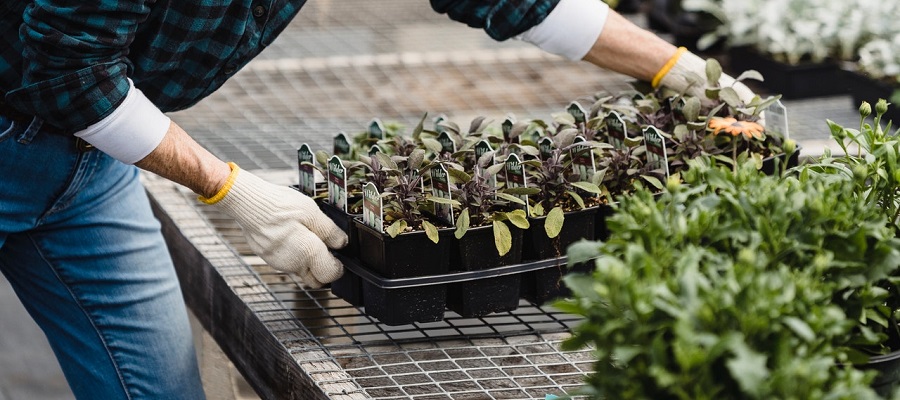In vertical farms, vegetable fields are no longer weeded but stacked. This makes large-scale farming possible even in confined spaces or in cities. But how sustainable is this futuristic concept?
At first glance, vertical farms seem bleak: There are no rabbits, and even otherwise, what some call the future of agribusiness doesn't exactly evoke romantic feelings of nature. Instead of sunshine, it's mostly LED lights that shine here. Sometimes the shelf beds even go for a drive to actually get the optimum amount of daylight or LED light.
The greens and fruits that thrive in Vertical Farms don't even need soil anymore: modern methods such as hydroponics (growing in water-filled containers) or aeroponics (using sprays) ensure that the plants are supplied with water and nutrients at optimal levels.
Vertical Farms: Less space required, more yield
The liquid requirements of these growing methods are comparatively low, and when intelligent systems are at work, vertical farms are largely self-controlled. Computers fertilize and water their offspring, control temperature, measure growth and yield, and in this way collect data that is used to further optimize operations.
Some farms even house fish, which enrich the fertilizer water with nutrients as part of an aquaponics system and in return enjoy the water purified by the plants. Because the farms have a closed and controlled environment, many germs and bacteria must stay out. That's why the vertical farming method also uses fewer or no pesticides.
Also important: taste and shelf life. Thanks to added nutrients, food from vertical farms is sometimes perceived as tastier, which is due to the increasing nutrient poverty of many conventional soils. The longer shelf life that can be achieved with modern farming methods also plays a role for some countries and the food service industry.
Is vertical farming unnatural?
But the system is controversial. Critics consider vertical farming unnatural. "Farming itself is unnatural," counters Dr. Dickson Despommier, ex-professor of environmental health and pioneer of Vertical Farming. Despommier isn't the only one interested in the efficiency of vertical farms and researching their sustainability.
And for good reason: Vertical Farms are believed to be able to feed a growing world population efficiently and in a relatively carbon-neutral way. The largest vertical farm of the near future, Crop One in Dubai, will soon be able to produce up to 3,000 kg of vegetables per day (!).
Vertical Farms: Vegetables from the Desert
This is amazing considering the climate that prevails in large parts of the Arab Emirates: heat coupled with drought. Fruits and vegetables therefore have to be flown in at great expense - which not only drives up prices, but also causes high CO2 emissions.
No wonder Dubai is enthusiastic about a vertical farm like Crop One, which can produce tons of vegetables in a small space and with little water. In the future, the Emirates want to supply passengers of numerous airlines with fresh food from their own country.
However, Crop One has not yet been completed. The world's largest vertical farm is currently located in New Jersey, where the company AeroFarms operates a 6,500-square-meter vertical farm that produces more than 900 tons of food per year. The harvested vegetables mainly go to the supermarket.
Plants at AeroFarms grow on reusable nets made from recycled microplastic and are powered by computers. Water consumption is only 5 percent of what is needed in conventional agriculture. Space consumption is also much lower: per square meter, the yield is 350 times higher than before. No wonder, fields can't be stacked, after all.
Vertical farms: Are they really sustainable?
But how sustainable are vertical farms really? On the one hand, there are arguments against conventional agriculture: it is globally responsible for one-third of our CO2 emissions, pollutes water with fertilizers and pesticides, and encourages natural disasters because large areas are cleared.
Conventional agriculture is also partly responsible for less biodiversity and species extinction. It also encourages long transportation distances. Vertical farms score better on all these points.
On the other hand, the argument in favor of conventional farming is how important, for example, microorganisms from the soil are for human intestinal health. This soil is missing in vertical farms; instead, microorganisms and nutrients must be artificially added to the irrigation. This does not necessarily meet with understanding - or even stirs up fears.
Also questioned are the masses of LED lamps that not only consume energy day and night, but also have to be manufactured and disposed of: A relevant contribution to the ecological footprint of Vertical Farms. In addition, many jobs could be lost if agriculture becomes more "verticalized" and thus more efficient.
For others, something as industrial as a vertical farm that is supposed to deliver something as natural as parsley simply does not inspire much confidence. Is this still 'normal' fruit and vegetables?
Even cultivated soils are not exactly brimming with naturalness: they also have to be fertilized and sprayed with pesticides.
Vertical Farms: What Science Says
Science should help weigh the pros and cons. Research currently focuses on the nutritional value of the fresh food grown in vertical farms, as well as a life cycle analysis that records the environmental impact of a complete vertical farm from its birth to its demolition.
In terms of sustainability, there are initial studies that not only attribute potential to Vertical Farms, but even consider them necessary: In 2018, for example, the Fraunhofer Institute emphasized in one of the largest surveys to date on the topic that the consequences of climate change could significantly limit the growth of the agricultural industry in the future.
Another study concluded in 2018 that vertical farms bring more ecological advantages than disadvantages on a global scale, but also showed that the farming method appears to make more or less sense depending on the region.
The consequence: the capacities of conventional agriculture may no longer be sufficient for a growing world population. Affordable solutions - such as vertical farms - are needed.
Overview of the advantages and disadvantages of vertical farming
Vertical farms therefore have various advantages and disadvantages. Here is an overview.
These are the advantages of vertical farming:
No long transport routes or refrigeration: this saves resources and less food spoils during transport.
Efficient use of land: by growing crops on multiple levels, small areas can feed many people.
Water consumption is reduced: Since water does not seep or evaporate in the recirculating system of vertical farming, water consumption is lower than in the field.
Year-round harvesting possible: Since Vertical Farms are not exposed to the changing seasons, yields are significantly higher.
Crop failure protection: Plants grow in a controlled environment and are independent of climatic conditions or other environmental factors. This is particularly advantageous in view of climate change, as extreme
weather events are becoming more frequent.
Fewer sprays and fertilizers: The controlled environment already provides good growing conditions, so fewer pesticides are needed. But: If pest infestation does occur, these optimal conditions can also become a disadvantage, since the pests also benefit from them. Large quantities of pesticides are then needed to stop the aggressive infestation.
Exotic fruits and vegetables available regionally: Exotic plants can also be grown in adjustable greenhouses.
Areas can be renaturalized: By using land more efficiently, fields can be returned to their natural state. This conserves resources.
Renewable energy sources: The energy needs of vertical farms can be met by solar cells attached to the building, for example. But organic waste produced can also be used directly to generate electricity in a nearby biogas plant.
Improved air quality: The oxygen produced by the plants can upgrade the air in urban areas.
Reduced risk of accidents for workers*: Compared to field farming, vertical farming does not expose workers to pesticides or other health risks often associated with field farming.
Low labor costs: Almost all processes are automated.
This speaks against vertical farming:
- Additional energy consumption and costs: Vertical farming involves artificial irrigation, ventilation, lighting and monitoring. The construction of a vertical farm is also associated with high costs. However, if renewable energy sources are consistently used, crops can still be grown sustainably.
- Long road to economic viability: High energy costs and large start-up capital can partially offset saved transportation costs. Urban farms are thus not always profitable, especially in the early years.
- No solution to world hunger: staple crops such as wheat, potatoes, corn or rice are less suitable for floor cultivation and still require large areas of agricultural land.
- Germ risk persists: Germs can occur even in controlled environments. In this case, the disease can spread very quickly because there are no disruptive factors for the invaders either.
- Threatens the survival of small farms: Vertical farms are particularly profitable on a large scale. Investors are needed to implement such a project, which creates a dependency on large corporations. In addition, jobs are lost due to automated systems.
- A lot of technology needed: Also controversial from an ecological point of view is the large amount of technology required, such as LED lamps, which have to be produced and disposed of again. The construction of a vertical farm also leaves a large ecological footprint.
- Risk of crop failure persists: even if climatic factors no longer play a role, some large building complexes make the food supply all the more vulnerable. In the event of power outages, earthquakes, accidents or even sabotage, the supply system of an entire city could collapse.
Vertical Farms: Already in Europe, too
At around 100 million U.S. dollars, a vertical farm is of course no bargain, and about 20 million U.S. dollars per year should be added for maintenance. This is offset by higher efficiency, lower transport costs and the possibility of year-round production. Sales can also be better calculated.
In the best case scenario, the farms will be designed as part of a circular economy, with no waste and powered only by renewable energies.
This makes the concept attractive not only for oil states. Other countries are not idle either: In Australia, "modular farms" are already being sold in containers that can be used anywhere. In England, JFC operates a farm that, at 17 stories, is almost as large as that of AeroFarms in the USA. Infarm from Berlin, on the other hand, has set itself the task of integrating particularly small vertical farms into the Berlin urban landscape in order to serve local markets.
So will our vegetables soon be coming from the city on a grand scale? That's not far-fetched, but the answer doesn't just depend on potential investors. Water and land are not yet as scarce a commodity here as they are in other parts of the world. But if we take a look at our ecological footprint, vertical farming could soon be worthwhile in this country, too - both ecologically and economically.


